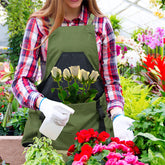When to Harvest Potatoes from Grow Bags: A Complete Guide
Table of Contents
- Introduction
- The Growth Cycle of Potatoes
- Signs of Readiness for Harvesting Potatoes
- How to Properly Harvest Potatoes from Grow Bags
- Storing Your Homegrown Potatoes
- Conclusion
- Frequently Asked Questions
Potatoes have long been a cherished staple in gardens and kitchens alike, beloved for their versatility and heartiness. Did you know that potatoes can be grown in bags, making them accessible for those with limited space? As we embrace this innovative method, one question often arises: when to harvest potatoes from grow bags? Understanding the right time to reap the fruits of our labor is crucial to enjoying the best flavor and quality from our homegrown tubers.
In this blog post, we will delve into the intricacies of harvesting potatoes from grow bags, exploring everything from the growth cycle of potatoes to the signs of readiness that indicate it's time to harvest. We'll guide you through the best practices for ensuring a bountiful harvest while emphasizing our commitment at Garden Greenland to provide high-quality gardening products that enhance your gardening experience. Together, we’ll ensure that you maximize your yield and enjoy the satisfaction of homegrown potatoes.
Introduction
Potatoes are not just easy to grow; they are also one of the most rewarding crops to cultivate. Whether you are an experienced gardener or just starting your green journey, growing potatoes in grow bags offers a practical and space-saving solution. Imagine the joy of digging up fresh, delicious potatoes right from your patio or balcony, no traditional garden required!
The idea of growing potatoes in bags has gained popularity due to its convenience and efficiency. This method allows us to control soil quality, drainage, and pest management more effectively than in-ground planting. However, knowing when to harvest is vital to ensure we enjoy the best flavor and texture from our tubers.
By the end of this article, you will understand the factors that determine the best time to harvest potatoes from grow bags, how to recognize the signs of readiness, and the proper techniques for harvesting and storing your potatoes. We’ll also highlight how our premium gardening products at Garden Greenland can support you in every step of your gardening journey.
As we explore the various stages of potato growth, we’ll cover critical topics such as:
- The growth cycle of potatoes
- Signs that indicate readiness for harvest
- How to properly harvest and store potatoes
- Tips for maintaining your grow bags for future crops
Get ready to dive deep into the world of potato harvesting, ensuring that your gardening efforts yield delicious and nutritious results!
The Growth Cycle of Potatoes
Before we can determine when to harvest potatoes from grow bags, we must first understand their growth cycle. Potatoes typically go through several stages from planting to harvest, each characterized by distinct developments.
1. Planting and Initial Growth
After planting chitted seed potatoes in your grow bags, the initial growth stage begins. This typically occurs within 10 to 14 days post-planting, depending on conditions such as temperature and moisture. During this time, you will see shoots emerging from the soil as the plants begin to establish themselves.
2. Vegetative Growth
Following the initial growth, the vegetative stage is marked by the development of foliage. This stage is crucial as the leaves play a significant role in photosynthesis, which provides the energy required for tuber formation. Generally, this stage lasts for several weeks, and you should ensure your plants receive adequate sunlight, water, and nutrients.
During the vegetative phase, you can promote healthy growth by regularly watering the plants and applying a high-potash fertilizer every couple of weeks. This will encourage strong foliage development and ultimately contribute to a more substantial harvest.
3. Flowering Stage
After the plants have established a robust vegetative structure, they will enter the flowering stage. This is an exciting time as it indicates that tubers are starting to form below the soil surface. Depending on the variety, flowering typically occurs around 6 to 10 weeks after planting.
For early varieties, such as 'Swift' or 'Rocket,' flowering may happen sooner, while maincrop varieties will take a bit longer. It’s important to note that not all potato varieties produce flowers, but when they do, it’s a good indication that tubers are developing.
4. Maturity and Readiness for Harvest
The final stage in the growth cycle is maturity. This is when the foliage starts to yellow and die back, signaling that the tubers have reached their full size and are ready for harvesting. For early varieties, this may occur around 70 to 90 days after planting, while maincrop potatoes may take 90 to 120 days.
Recognizing the right time to harvest is essential in preventing over-mature tubers, which can lead to tough skins and poor storage qualities.
Signs of Readiness for Harvesting Potatoes
Knowing when to harvest potatoes from grow bags can be tricky, especially since the tubers grow underground and are not visible. However, several signs can help us determine the optimal time for harvesting:
1. Foliage Changes
The most significant indicator of potato readiness is the condition of the plant’s foliage. When the leaves begin to yellow and wilt, it's a sign that the tubers are maturing. For early potatoes, this may happen shortly after flowering, while maincrop varieties may take longer.
To ensure the best flavor and texture, it's crucial to wait until the foliage has died back completely before harvesting storage potatoes. This dying-back process allows the skins to thicken, enhancing their storage quality.
2. Size of the Plants
Inspect the size and vigor of your plants. If they appear healthy and robust, it’s likely that the tubers are developing well underneath. You can gently feel around the base of the plants to check for tubers without disturbing the soil too much.
3. Test Harvesting
If you’re unsure whether your potatoes are ready, consider performing a test harvest. Carefully dig around the base of one plant to see if tubers have formed and their size. If they are still small, allow the plants to grow for a few more weeks before checking again.
4. Days to Maturity
As mentioned earlier, different potato varieties have varied days to maturity. Familiarize yourself with the specific variety you planted, as this will help you gauge when they will likely be ready for harvest.
For example, first early potatoes are generally ready about 70 to 90 days after planting, second earlies around 90 to 100 days, and maincrop potatoes can take 100 to 120 days. Keeping track of these timelines will assist you in planning your harvest.
How to Properly Harvest Potatoes from Grow Bags
Once you've determined that your potatoes are ready to be harvested, the next step is to do so correctly to avoid damaging the tubers. Here’s how to harvest your potatoes from grow bags effectively:
1. Prepare for Harvest Day
Choose a dry day for harvesting, as wet conditions can lead to soil sticking to the tubers and increase the risk of disease. Gather the necessary tools, such as a garden fork or spade, and prepare a clean surface where you can lay out the harvested potatoes.
2. Remove the Grow Bag
Carefully lift the grow bag and place it on a flat surface. If your bag is heavy, consider rolling it to make it easier to manage.
3. Digging Up the Potatoes
Using a garden fork, gently insert it into the soil at the edge of the bag and lift the soil mixture to expose the tubers. Be cautious not to pierce or cut the potatoes while digging, as this can affect their storage quality.
4. Collect the Potatoes
Once you’ve exposed the tubers, hand-pick them from the soil. Place them gently in a container, being mindful to separate any damaged potatoes, which should be used immediately rather than stored.
5. Cleaning and Curing
After harvesting, gently brush off any excess soil from the potatoes without washing them. Washing can remove protective layers and lead to quicker spoilage. Instead, place your harvested potatoes in a cool, dark, and well-ventilated area for curing. This process helps to thicken the skins and prolong storage life, lasting one to two weeks.
Storing Your Homegrown Potatoes
Proper storage is essential for maintaining the quality of your homegrown potatoes. Here are some tips for storing them effectively:
1. Ideal Storage Conditions
Store your cured potatoes in a cool, dark, and well-ventilated area, ideally between 40-45°F (4-7°C). A root cellar is optimal, but if you don’t have access to one, a basement or cool garage can work well. Ensure that the storage area remains dry to prevent rot.
2. Use Appropriate Containers
Avoid using plastic bags for storage, as they can trap moisture and lead to rot. Instead, utilize breathable containers like mesh bags, cardboard boxes, or wooden crates that allow for good air circulation.
3. Check Regularly
Inspect your stored potatoes regularly for signs of spoilage, and remove any that show signs of rot or sprouting. This will help ensure that the remaining potatoes stay fresh and healthy for longer.
4. Prevent Greening
Exposure to light can cause potatoes to turn green and produce solanine, which is toxic. To prevent greening, keep your potatoes in a dark environment and cover any transparent storage containers with cardboard or cloth.
Conclusion
Harvesting potatoes from grow bags can be a rewarding experience, allowing us to enjoy the fruits of our labor while maximizing space and convenience. By understanding the growth cycle of potatoes, recognizing the signs of readiness, and employing proper harvesting and storage techniques, we can ensure a bountiful yield of delicious tubers.
At Garden Greenland, we are committed to supporting you on your gardening journey. Our premium gardening products, from high-quality grow bags to ergonomic tools, are designed to enhance your experience and help you achieve your gardening goals effortlessly. Together, let's cultivate the joy of growing potatoes and elevate our connection to nature.
Frequently Asked Questions
1. How long does it take for potatoes to grow in grow bags? Potatoes typically take between 70 to 120 days to mature, depending on the variety. Early varieties may be ready in about 70 to 90 days, while maincrop varieties take longer.
2. What size grow bag is best for potatoes? A minimum of a 25-gallon grow bag is recommended for potatoes, but larger bags (50 gallons or more) can yield better results by providing ample space for tuber development.
3. How do I prevent rot in my potatoes? To prevent rot, ensure proper drainage in your grow bags, avoid overwatering, and store harvested potatoes in a cool, dry, and dark environment.
4. Should I wash potatoes after harvesting? No, it’s best to avoid washing potatoes after harvesting. Instead, brush off excess soil and allow them to cure in a cool, dark place for better storage quality.
5. Can I grow potatoes from supermarket potatoes? It is not recommended to grow potatoes from supermarket varieties, as they may carry diseases. Instead, use certified seed potatoes for the best results.
By following these guidelines, you’ll be well on your way to enjoying a rewarding potato harvest from your grow bags. Happy gardening!









